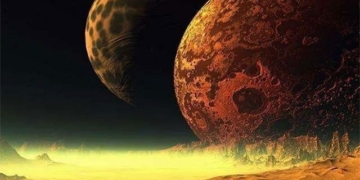Scientists have recently discovered an extreme super-Earth with a surface even hotter than some stars in the universe.
Super-Earth TOI-6713.01 is located approximately 66 light-years away from us and is so volcanic that its molten surface glows with a terrifying bright red hue.
Some scientists have compared it to the fictional planet Mustafar, a lava world from the Star Wars films, according to Space.com.

Super-Earth TOI-6713.01 glows red like the fictional planet Mustafar – (AI-generated graphic).
Meanwhile, Dr. Stephen Kane from the University of California, Riverside, the lead researcher, stated that it is almost akin to Jupiter’s moon Io, a world with hundreds of volcanoes erupting around the clock.
However, Io is considered the “tamed” version of TOI-6713.01, as this exoplanet exhibits far more intense volcanic activity, resulting in its surface being perpetually inundated with molten lava.
According to a study published in The Astronomical Journal, TOI-6713.01 is a rocky planet that is 30% larger than Earth, thus qualifying it as a super-Earth. It orbits its parent star HD 104067 in just 2.2 Earth days per cycle at a distance of only 4.57 million kilometers.
This star system also contains two other worlds, including a rocky planet that orbits about 15.8 million kilometers from the parent star and a gas giant located approximately 40 million kilometers away.
All three of these distances are relatively short. In our Solar System, Mercury, the innermost planet, is at a distance of 46 million kilometers from the Sun at perihelion and 69.82 million kilometers at aphelion.
Similar to Mercury, the orbit of TOI-6713.01 is quite elliptical. In Mercury’s case, the distance from the Sun is far enough that it is not significantly affected by the scorching heat when it is near or far during its perihelion and aphelion.
However, this super-Earth, referred to as “hellish,” is so close that it is almost “touching” its star, thus experiencing immense gravitational forces.
The continuous gravitational interactions stretch the planet and twist its molten interior, creating extreme tidal effects.
This phenomenon provides the energy needed for the volcanoes on TOI-6713.01 to remain continuously active.
The planet’s molten surface reaches temperatures of 2,327 degrees Celsius, making it even hotter than many stars in the universe.
Scientists discovered this planet by meticulously sifting through data from TESS, NASA’s “exoplanet hunter,” which is dedicated to seeking out Earth-like worlds with the hope of identifying potential habitats for life.
TOI-6713.01 is certainly uninhabitable, but it serves as an example of the incredibly diverse and extreme worlds that exist among exoplanets.


















































